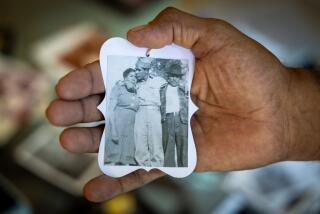Back Off, Bakersfield
BECAUSE HE STILL WRITES AND SINGS about it, Merle Haggard’s past is never entirely behind him, especially in Kern County, where he was born and raised.
A few years ago, when a new Amtrak station opened in Bakersfield, some residents asked that it be named for Hag. Letters to the editor immediately bombarded the Bakersfield Californian and made it clear that his youthful indiscretions--and time in San Quentin--had not been forgiven in this self-consciously Christian county. Several of the missives suggested that the hoosegow would more appropriately be named for him.
Despite that, Don Jaeger of the Greater Bakersfield Convention & Visitors Bureau recently urged that a 500-foot section of S Street--essentially a long driveway into the train station--be named Merle Haggard Way. This awakened folks in Oildale, the unincorporated community north of Bakersfield where Haggard actually grew up. Said one resident there, “That’s the pattern: Get successful and Bakersfield claims you.” A group called Citizens for a New Oildale, as well as Tom Clark, the recently retired general manager of the Kern County Water Agency, formally protested. Clark, who had planned to propose recognizing Haggard in their hometown, realized that this was much ado about something: a little burg’s battered pride.
In the eyes of some, Oildale itself is as much a problem as Haggard. Said a letter to the Bakersfield Californian in response to Jaeger’s idea, “Haggard exemplifies the stereotypical resident of Oildale. . . . I would like the Citizens for a New Oildale to consider my suggestion to name a facility, such as the county’s Lerdo Jail, for Haggard.” His rare talent, for which he’d just won a lifetime achievement Grammy, was not the stereotype the writer referenced; she apparently had not gotten past “breaking and entering” 50 years ago.
Hypocrisy is alive and well in Bakersfield. The irony is that we Oildale boys know Haggard’s real crime was allowing himself to get caught. Let’s just say he wasn’t the only kid to climb through the wrong window in those days.
WHAT MAY BE CALIFORNIA’S MOST FAMOUS boxcar sits on the back of a lot on Yosemite Drive in Oildale. More than 60 years ago the Haggard family lived there while the father, James, worked for the railroad and his younger son, Merle, joined pals to stalk the surrounding streets. Unprosperous as it was then, the neighborhood seems to have slid further downslope today, with too many adults home all day, too many decrepit cars in front of rented houses and too few diplomas anywhere. It feels absent of hope.
That’s only one neighborhood in a solid, working-class community with good schools and ambitious kids, but burdened by an enduring reputation for deep poverty and accompanying crime. The odd thing is that Oildale’s poverty rate is virtually the same as Kern County’s and only slightly higher than Bakersfield’s, but it has continued to be cast as a pit of privation. That reputation lingers because the poor in Oildale are overwhelmingly white (the code word is Okie); they threaten racial illusions in a county with plentiful black and brown destitution.
Supposed bigotry is another burden the community bears. Oildale grew early in the last century near the Kern River oilfield, a collection of company camps and small settlements--Oil Center, Standard Camp, Riverview--that coalesced. At that time, dairies and farms, the Kern River and a certain frame of mind separated it from Bakersfield. Most early residents were Southwestern males who didn’t give a hoot for genteel aspirations; the new town quickly developed a reputation for roughness and racism.
During the Great Depression, the San Joaquin Valley attracted hordes seeking agricultural work, but didn’t much reward them until World War II heated up the state’s economy. Well into that war, along Oildale’s south border, the Kern River, a large Hooverville was filled with desperate migrants. Many of the children raised there became the first in their families to finish high school and to enter the middle class. Many have climbed much higher.
Nevertheless, Oildale was to Bakersfield what Bakersfield was to Los Angeles, a convenient punch line: Blowing your nose with your fingers was an “Oildale handkerchief.” A fiancee in Oildale was called “sister.” And on and on and on. Those slights have left scars. Locals remain pugnacious, resisting suggestions that they allow Bakersfield--which nearly surrounds the smaller town--to annex it. (Some newcomers, though, pretend that Oildale doesn’t exist; they live in “North Bakersfield,” whatever that is.)
Little wonder that Tom Clark paid $675 to formally appeal the S Street decision. He also fired off a letter to the Californian that spoke for many of us when it said, “Merle Haggard is Oildale’s native son, born and raised. . . . For those of us that grew up in Oildale, there is a fierce independence and a love for our hometown that was partly born out of year after year after year of Bakersfield’s rotten redneck Oildale jokes.”
Despite such sore spots, the community has in recent years learned to laugh at itself: Local boys Clete Harper and Terry Hill turned the stereotype on its ear when they founded the Oildale Winery and produced Redneck Red and White Trash White, available in a two-pack designed to look like an outhouse. Having bested the Napa Valley--their wines (or their labels, at least) soon became collectors’ items--Harper and Hill then released Dos Okies Beer, leading to problems with the makers of Dos Equis. Their hometown loved it.
Terry Hill’s father, Jack, was the first principal of the high school in Oildale in the 1950s. At the time Hag and the rest of us were growing up, though, the only high schools were in Bakersfield. Most Oildale kids didn’t know we were considered white trash until we entered the ninth grade there and our status was brought to our attention, leading to more than a few fistfights.
When a secondary school in Oildale was at last approved, the school board determined to name it Alfred Harrell High School, after the late publisher of the Bakersfield Californian, a major cog in the statewide anti-Okie campaign of the 1930s. Locals, my father among them, made it clear that no such name, and possibly no such building, would last long. A neighbor said, “We’re through a-suckin’ hind teat,” and he joined the protesters crowding the next school board meeting. The board relented, but still refused the name Oildale. In another slap, the school was called North-of-the-River High School.
Despite that name, North High and its graduates have become sources of great pride in a community overtly committed to family. There have always been plenty of churches here, many of them transplanted along with the people from the Southwest: Four Square Gospel, Church of the Nazarene, Pentecostal Holiness, and we had holy-roller tent revivals too (kids loved to sneak into them, better than movies). When Hag and I were growing up there was no Catholic Church, so we thought of Catholicism as a splinter sect.
There were plenty of saloons too, and most of our fathers preferred them to churches. Within a few blocks of my house could be found a half a dozen bars where guys met after work. Camaraderie and philosophy (“Fast as this beer goes through you, hoss, I reckon we just rent it”) seemed as important as suds. Oral virtuosity was common, probably because so many of our kin and neighbors employed the oral traditions of Texas, Oklahoma, Missouri, Arkansas and thereabouts. One older man said of the young Haggard, for instance, “That kid’s wild as a acre a snakes.”
We heard those things because during our boyhoods people emerged from their houses at dusk and visited. Some even played guitars and sang (“T for Texas” was popular, as was “Oklahoma Hills”). When television and air-conditioning arrived almost concurrently in the 1950s, though, those neighborly sessions soon stopped.
The area around Oildale could be wondrous to kids: Great towers of black smoke might rise from oil sumps being burned clean, while nearby the Kern River’s startling riparian forest penetrated desert terrain. Northeast, the foothills where we parked with our girlfriends were forested not with trees but with countless wooden oil derricks. But now even those are gone. The world in which we grew up remains only in our memories.
TOM CLARK’S EFFORT PICKED UP INFLUential support as more and more people learned of the controversy. Less than a month later, the Bakersfield Californian published an enlightened editorial: “A hometown celebrity should be honored in his hometown, not in a big city that often shuns Oildale and didn’t seem to have much use for the youthful, rowdy Haggard when he was growing up.”
Saying he had just wanted “to honor Merle,” Jaeger backed off and the Visitors Bureau withdrew its request. Because no hearing was necessary, Tom Clark’s $675 was returned to him.
Now, everyone from elementary school kids to oilfield roughnecks is offering an opinion about what Oildale might name for Hag. Clark has received a suggestion from Trout’s--”the last 7-night-a-week live music honky-tonk on the West Coast,” as he describes it--that a street or streets be named that will lead folks from Highway 99 to the bar. “So the beat goes on,” Clark says.
As for me, it really doesn’t matter as long as it’s a lane connecting Oildale with the wider world. Just like Haggard’s songs have done.
More to Read
Sign up for Essential California
The most important California stories and recommendations in your inbox every morning.
You may occasionally receive promotional content from the Los Angeles Times.










